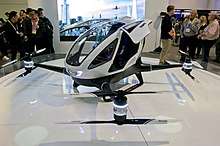Passenger drone
A passenger drone (also known as a drone taxi, flying taxi, or pilotless helicopter) is a type of personal air vehicle (PAV). The first passenger drone was introduced at the Consumer Electronics Show (CES) 2016 by Chinese entrepreneurs and is called the Ehang 184.[1][2]

Overview
The use of UAVs, or drones, has been popular in recent years.[3] Once used primarily for recreation by hobbyists, drones are now used in military operations and for conducting research. More recently, commercial companies have explored using drones to transport merchandise. Since 2011, several commercial developers and amateur builders have conducted short manned flights on experimental electric multi-rotor craft.[4] In January 2016, the first commercially produced drone capable of carrying a human was introduced by Chinese entrepreneurs at CES 2016.[5]
History
Radio controlled model airplanes have been a popular hobby since the 1970s. Drones, especially electric powered multi-rotor craft, have only emerged among hobbyists in the past ten to fifteen years. Drones differ from model airplanes in that they implement a measure of autonomy in their operation. Aerial drones have been used by militaries since World War II. Military drone capability expanded rapidly at the end of the twentieth century. Military drones have seen extensive use during campaigns in Iraq and Afghanistan.
Throughout the twentieth century and more recently, designers have proposed and developed many radical ideas for personal flight. Among these are the personal jetpack introduced in the 1960s, the Aeromobil flying car concept of the early 1990s, and the Terrafugia flying vehicle concept of 2006. While these are steered by the pilot, and thus are not technically considered drones, they nevertheless serve as inspirational precursors to the flying passenger drones being developed today.[6]
Future use of passenger drones
The future of passenger drones remains uncertain since this technology is so new. Innovation in aerial drone technology, and in aerial traffic coordination, control, and collision-avoidance could result in rapid proliferation of passenger drones for civilian travel. Several companies are exploring the use of passenger drones as air-taxis and for air-ambulance services.[7] Passenger drone developers are working to overcome many challenges, including noise, small useful load, short flight times, airspace regulations, and scarce data on both safety and general operations.
See also
- Air taxi
- Flying car (aircraft)
- Personal air vehicle
References
- "First passenger drone makes its debut at CES". The Associated Press. The Guardian. Retrieved 24 February 2016.
- "World's first passenger drone unveiled at CES". Reuters. Retrieved 16 June 2016.
- Henshon, M; Whittemore, G. "Drones on the Horizon! Getting Ready for Unmanned Aerial Vehicles (UAVs)". The American Bar Association. Retrieved 24 February 2016.
- "Four quadrocopters propel a real live human into aviation history (video)". The Verge. 2011-11-02. Retrieved 2017-03-29.
- McCoy, S. "Passenger 'Drones' To Carry People Thru The Sky". GearJunkie. Retrieved 24 February 2016.
- Priestley, T. "Flying Cars, JetPacks, And Passenger Drones - Which One Will Rule The Skies?". Forbes. Retrieved 24 February 2016.
- Darack, Ed. "Are Dubai's Drone Taxis For Real?". Air & Space Magazine. Retrieved 2017-03-29.